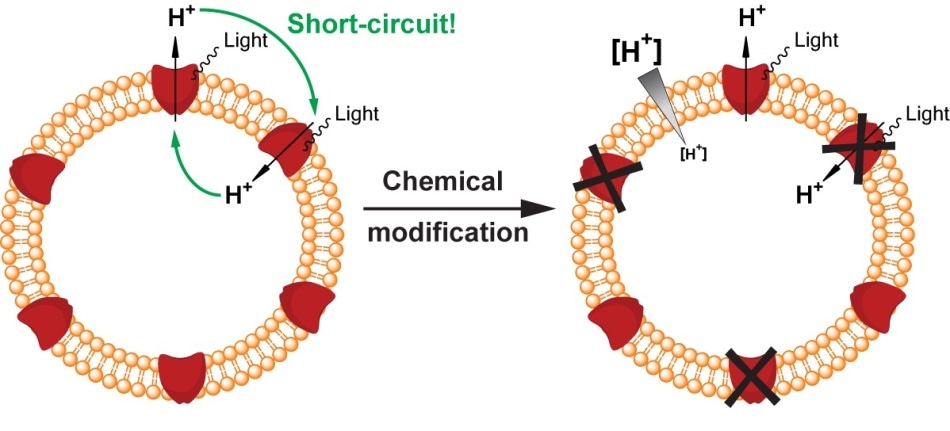Aug 10 2016
 Nanocontainer consisting of lipid (in orange) and the engineered version of proteorhodopsin (in red). Light irradiation of the molecular system fails in establishing a proton gradient across the membrane because of the symmetrical integration of proteorhodopsins, which results in a short-circuit (left). After chemically switching off wrongly oriented proteorhodopsins (right), correctly oriented ones can establish a proton gradient across the membrane (indicated in gray). (Photo Credit: Dimitrios Fotiadis, University of Bern.)
Nanocontainer consisting of lipid (in orange) and the engineered version of proteorhodopsin (in red). Light irradiation of the molecular system fails in establishing a proton gradient across the membrane because of the symmetrical integration of proteorhodopsins, which results in a short-circuit (left). After chemically switching off wrongly oriented proteorhodopsins (right), correctly oriented ones can establish a proton gradient across the membrane (indicated in gray). (Photo Credit: Dimitrios Fotiadis, University of Bern.)
Synthetic biology is an emerging and rapidly evolving engineering discipline. Within the NCCR Molecular Systems Engineering, Scientists from Bernese have developed a version of the light-driven proton pump proteorhodopsin, which is chemically switchable and it is also an essential tool to efficiently power synthetic cells and molecular factories.
Synthetic biology is a highly complex field with numerous knowledge branches that incorporate physics, biology, and chemistry into engineering. It aims to design synthetic cells and molecular factories with innovative functions or properties that can be applied in medical and biological research or healthcare, industry research.
These artificial systems are available in the nanometer scale and are developed by assembling and combining current, synthetic or engineered building blocks (e.g., proteins). Molecular systems are applicable for a wide range of applications, for instance these systems can be used for waste disposal, medical treatment or diagnosis, energy supply and chemical compound synthesis.
Under the given circumstance, the NCCR Molecular Systems Engineering has enabled Swiss scientists from various disciplines to work together in order to resolve current and future challenges and also stimulate innovation. Fotiadis laboratory in the NCCR MSE represents the University of Bern.
Nanomachines for Energy Conversion
Building blocks that provide energy are essential to power molecular systems. Proton pumps such as the membrane protein proteorhodopsin that are stimulated by light exhibit excellent properties of nanomachines for systematic energy conversion. Solar energy, a form of light energy, is convenient to access and at the same time efficiently used by proteorhodopsin to initiate proton gradients across membranes that help in the separation of two different compartments.
These gradients be used later to drive proton-driven building blocks of molecular systems, for instance transporters that are stimulated by proteins. Living cells often make use of proton gradients to power processes such as export and import of ions and solutes through transporters, and the synthesis of metabolites.
Eliminating the Short-Circuit
In general, usage of common methods to assemble proteorhodopsin, and membrane proteins into containers such as liposomes or polymerosomes referred to as spherical structures consisting of lipid or polymer membranes, symmetric implementation in membranes is observed to lead to failure and short-circuit in establishing a proton gradient.
Consequently, members from the Fotiadis group, in particular Dr. Daniel Harder and Stephan Hirschi, together with colleagues from the NCCR MSE have implemented a chemical on-off switch into proteorhodopsin, thus improving its utility and allowing the innovation of an asymmetric distribution of functional proteorhodopsin proteins in membranes by particularly deactivating one of the two possible orientations.
This proteorhodopsin version that was engineered by the scientist represents the first light-driven proton pump and energizing-building block that can be alternatively deactivated and activated chemically according to the requirements of the molecular system.
Potential applications of the versatile building block that provides energy specifically in molecular factories represent the solar- and light-powering of the production of molecules such as life’s universal energy currency adenosine triphosphate (ATP) and of the bioremediation of pollutants such as antibiotics in water resources», says Fotiadis. The famous scientific journal «Angewandte Chemie International Edition» published this study.